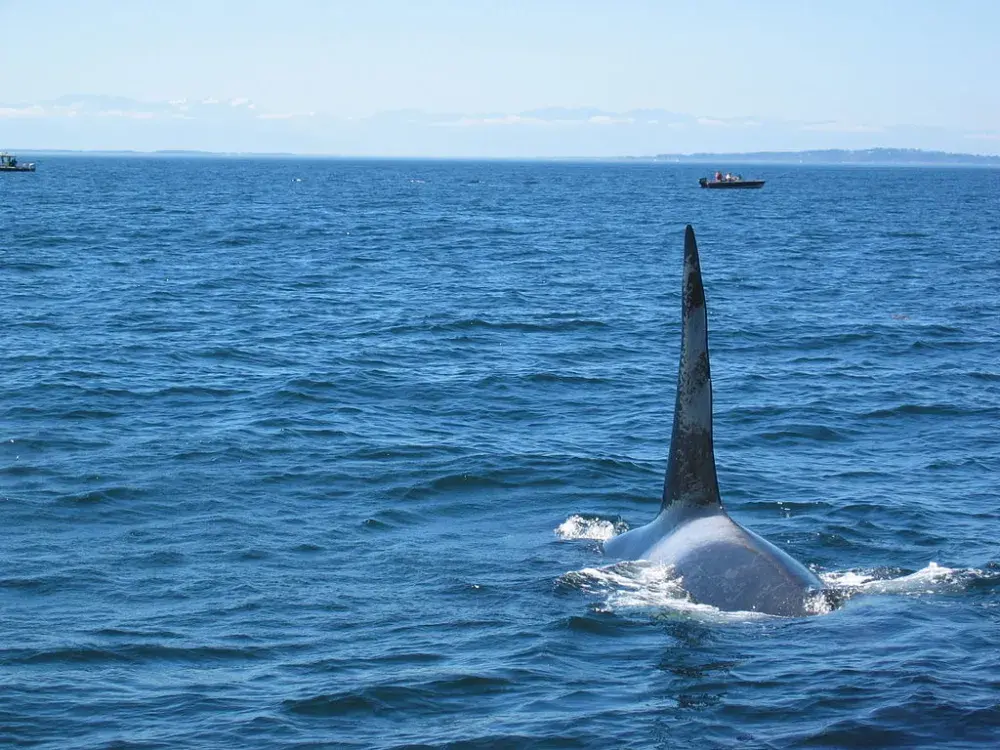Both resident killer whale populations around Vancouver Island are in danger; the Southern Resident Killer Whale (SRKW) population was listed as endangered in Canada’s Species at Risk Act (SARA) in 2001 and the Northern Resident Killer Whale (NRKW) population was listed as endangered in 2005.
The issue is so concerning to federal fisheries officials that they convened a symposium in Vancouver on Oct. 11-12, 2017.
Designed to improve understanding of what’s needed to protect the SRKW population and support its recovery, the Southern Resident Killer Whale Symposium brought together scientists, government officials and First Nations.
Both the endangered SRKW and the threatened Northern Resident Killer Whale populations feed mainly on salmon (chinook and chum) and cephalopods (i.e., octopus, squid). The transient orca feed mainly on marine mammals while the offshore populations feed mainly on fish and shark.
According to information from DFO, the SRKW population experienced declines of three per cent per year between 1995 and 2001, and since then has shown little recovery, having 80 members in 2016.
During the summer and fall, Southern Residents are primarily found in the transboundary waters of Haro Strait, Boundary Pass, the eastern portion of the Juan de Fuca Strait, and southern portions of the Salish Sea. This area is designated as critical habitat based on consistent and prolonged seasonal occupancy.
It is believed that the shrinking population is due to several factors, including lack of prey, environmental contamination (pollutions) and both physical and acoustic disturbance. Add to that, the small resident orca population and low reproductive rates.
NTC Fisheries Manager Eric Angel went to the symposium along with Central Region Biologist Jared Dick. They attended on behalf of Nuu-chah-nulth nations and will report back to the Ha’wiih at the next Council of Ha’wiih Forum on Fisheries in February of 2018.
According to Angel, several several presentations dealt with the issue of noise pollution in the waters off of Vancouver Island. Orcas rely on echolocation not only for communication but also for hunting. It is believed that man-made underwater noises along with boat strikes are taking a toll on the resident orca population. Yet this is only one possible contributing factor.
“There is no one single cause,” said Angel of the population decrease. Orcas are predators at the top of the food chain and are vulnerable to the effects of pollutants and the lack of prey, among other things.
Industrial pollution, agricultural run-off, forestry (spawning habitat destruction), sewage, oil spills and global warming are all contributing factors to the failing health of orca and salmon, and they are all man-made.
Angel noted that government representatives at the symposium presented issues and proposed solutions from a science-based perspective that didn’t consider the social, cultural and ceremonial significance of the kakawin to Aboriginal Peoples on the West Coast. He added that First Nations speakers from nations in the Salish Sea area talked about the importance of the health and well-being of the killer whale to their communities as they shared legends about the kakawin passed down to them by their elders.
“This is very sophisticated knowledge that is not the same as science,” Angel noted. The stories tell of how the killer whale is part of the community and should be cared for as a community or family member, whereas the science-based presentations didn’t include this as a consideration. “They say when the killer whale’s health is not good then we are not taking care of them,” Angel added.
“Some people dismiss these stories as anecdotal or just stories, but there’s tremendous value in First Nations knowledge,” said Angel, noting that the stories provide beneficial insights for killer whale population recovery. “They tell a story of how we may have gotten it wrong in the past and how we need to learn from it,” he continued.
One thing everyone agreed on at the symposium was the impact of low chinook stocks. Chinook and chum are main seasonal food sources for orcas and their decrease in our waters could be contributing to the kakawin’s decline.
“The nations are keen to work with the government on this,” said Angel. And while there’s been talk of 2018 chinook fisheries closures, Angel said that in the October fisheries forum the message from the nations was clear that they wanted to see more effort put into salmon habitat restoration and rebuilding of the chinook stocks.
It is not known what the residents eat in the winter so part of the government’s recovery strategy is to determine what the SRKW diets are year-round.
Transport Canada along with DFO, are working with the Vancouver Fraser Port Authority’s Enhanced Cetacean Habitat and Observation (ECHO) Program. ECHO is currently conducting a voluntary vessel slowdown in Haro Strait. The data collected on changes in the acoustic environment and whale behaviour will inform future federal actions. This and other initiatives are part of Canada’s $1.5-billion Oceans Protection Plan.
In the meantime, Angel expects that the government will soon announce new regulations that will affect the whale watching industry. The distance that boats approach whales is expected to increase from 100 metres to 200 metres.







